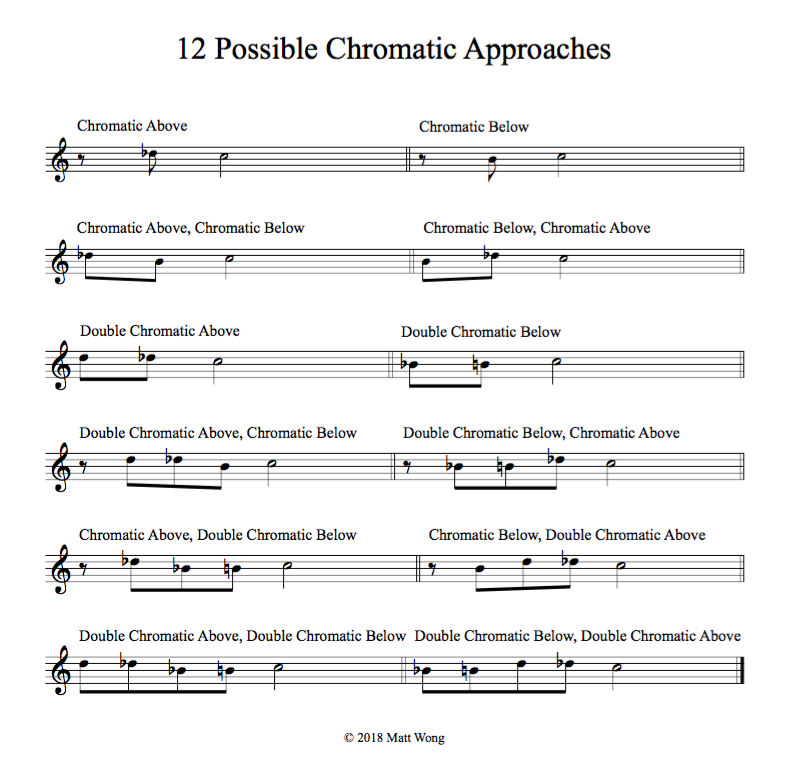
This month, I will be discussing how you can use approach notes in your soloing. Adding chromaticism to your improvisation with approach notes is a great way to spice up your playing, and is commonly used by jazz, rock, and fusion guitar players.
There are 12 chromatic approaches as well as 12 diatonic approaches that players can choose from, and many different ways to use them when improvising. As you can probably imagine, becoming proficient in using approach notes will take a bit of time. Thus, for this lesson, we will focus on two simple chromatic approaches, and use them to approach chord tones. If you have not already, I recommend checking out my lesson, "Bring Out the Sound of Each Chord in Your Solos." The exercises from that lesson will provide you with a good technical and theoretical foundation to tackle the ones in this lesson.
For those of you who wish to explore approach notes beyond this lesson, included at the end of this article is a list of all twelve possible chromatic approaches that you can apply the exercises in this lesson to. As always, do not hesitate to get in touch with me with questions.
1. Play arpeggios starting from every chord tone for the chords in the progression that you are working on, and practice approaching each chord tone from chromatic above. If you are playing a C major7 arpeggio, you will want to play the following arpeggios to practice approaching the root from chromatic above.

After practicing approaching the root, do the same thing with the 3rd, 5th, and 7th. Just a quick note—some chromatic approaches end up also being diatonic approaches, and that's okay. The purpose of this exercise is to help you become physically proficient in applying approach notes to your improvisation.
2. Repeat the exercise above, but practice approaching from chromatic below. Play the following arpeggios to practice approaching the root of a C maj7 chord from chromatic below.

Again, some of these chromatic approaches will also be diatonic approaches like in the example above.
All the latest guitar news, interviews, lessons, reviews, deals and more, direct to your inbox!
3. Compose a solo over the progression you're working on and incorporate chromatic above and chromatic below approaches. This is a great way to develop your own ideas and licks that you can use when you are improvising. The general guideline at this stage is to approach chord tones placed on strong beats (1 and 3). To help make your composed solo sound as musical as possible, make sure you vary where you start and end your phrases, vary the rhythms you use, and leave rest in between phrases. Once you have completed your solo, practice playing it on the guitar. I encourage you to also sing through your solo to practice your ear training.
- Below is an example of a short solo I composed using the approaches we discussed. Notice the chord tones that land on beats 1 and 3, and the chromatic notes that approach them.
You are welcome to email me a copy or recording of your solo if you would like me to look it over.
4. Improvise over the progression. Now you have the tools to start adding a little chromaticism to your playing. Remember to always strive to be musical in your soloing!

Helpful Resources: New York Guitar Method Volume 2
Matt Wong is a guitarist, composer, and educator from New Jersey. As a performer, Matt has played throughout the tri-state and New England areas as a live guitarist and pit orchestra musician. From his own studio, Matt works as a session musician and composer, overdubbing guitars, banjo, and mandolin for songwriters, producers, and composers in the United States and abroad (UK, Canada, Spain, and Israel), while also exploring scoring for various forms of media. As an educator, Matt teaches guitar, music theory, ear training, and improvisation, and offers lessons online via Skype. Matt uses pedals from Xotic and Walrus Audio as well as capos from Kyser. Follow Matt on Instagram.
